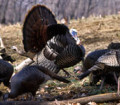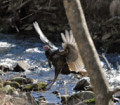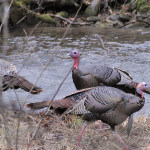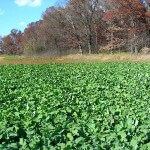John’s Note: The turkeys had gone, vanished. All the fine turkeys I’d seen the previous fall and looked forward to hunting that spring now lived on my neighbor’s property. I knew, because I could hear them gobbling their heads off the first morning of spring turkey season. Besides feeding turkeys and providing brood habitat, you need to remove the predators.
When I interviewed Dr. Dan Speake, retired cooperative research unit leader at Auburn University in Auburn, Alabama, about,
“What’s the quickest way to inc rease your turkey population after you’ve solved the habitat problem by planting food plots and/or creating brooding sites and nesting sites for the turkeys on the land you hunt?” Dr. Speake answered. “After studying several-hundred turkeys and using radiotelemetry to investigate turkey mortality, we’ve learned that approximately 25% of the hens are killed each year during the nesting and brood-rearing times. We’ve also learned that an average of 70% of the poults are killed within the first 2 weeks after they hatch.”
rease your turkey population after you’ve solved the habitat problem by planting food plots and/or creating brooding sites and nesting sites for the turkeys on the land you hunt?” Dr. Speake answered. “After studying several-hundred turkeys and using radiotelemetry to investigate turkey mortality, we’ve learned that approximately 25% of the hens are killed each year during the nesting and brood-rearing times. We’ve also learned that an average of 70% of the poults are killed within the first 2 weeks after they hatch.”
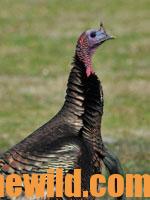 Speake put together a list of predators that killed turkeys, particularly hens and poults. In my home state of Alabama, free-ranging dogs took the number-one turkey-killer spot in Speake’s study area. Speake found that these free-ranging dogs primarily killed turkey hens as they sat on their nests. Raccoons made number two on the predator list with gray foxes, bobcats and coyotes following closely in incidents involving turkey hens sitting on eggs. Raccoons ranked as the number-one predator that disturbed hens and ate turkey eggs with possums, crows and gray foxes in next place. When Speake’s team of wildlife biologists turned their attention to young poults, they listed raccoons as the number-one predator; dogs, the number-two predator; and hawks, owls and snakes also responsible for few poult deaths. Your state may have different predators that attack wild turkeys.
Speake put together a list of predators that killed turkeys, particularly hens and poults. In my home state of Alabama, free-ranging dogs took the number-one turkey-killer spot in Speake’s study area. Speake found that these free-ranging dogs primarily killed turkey hens as they sat on their nests. Raccoons made number two on the predator list with gray foxes, bobcats and coyotes following closely in incidents involving turkey hens sitting on eggs. Raccoons ranked as the number-one predator that disturbed hens and ate turkey eggs with possums, crows and gray foxes in next place. When Speake’s team of wildlife biologists turned their attention to young poults, they listed raccoons as the number-one predator; dogs, the number-two predator; and hawks, owls and snakes also responsible for few poult deaths. Your state may have different predators that attack wild turkeys.
Have a 300% Increase in Turkeys:
Once Dr. Speake’s team of researchers determined the predators keeping their study area’s turkey numbers low, they quickly solved the problem. “We found that if we eliminated predation from the dogs, the coons and the possums, then the turkey population would grow rapidly, with about a 300-percent increase in the production of turkeys than before when these predators killed hens and poults, ate eggs and disturbed nests,” Speake explained. “We also learned that the older-age-class gobblers were almost never vulnerable to predators. Very rarely would an older gobbler put himself in a position in which a predator could attack and kill him.”
quickly solved the problem. “We found that if we eliminated predation from the dogs, the coons and the possums, then the turkey population would grow rapidly, with about a 300-percent increase in the production of turkeys than before when these predators killed hens and poults, ate eggs and disturbed nests,” Speake explained. “We also learned that the older-age-class gobblers were almost never vulnerable to predators. Very rarely would an older gobbler put himself in a position in which a predator could attack and kill him.”
You’ll learn many ideas for hunting turkeys in the Kindle eBook, “Turkey Hunting Tactics” by John E. Phillips.”Click here to get these books”.
About the Author
John Phillips, winner of the 2012 Homer Circle Fishing Award for outstanding fishing writer by the American Sportfishing Association (AMA) and the Professional Outdoor Media Association (POMA), the 2008 Crossbow Communicator of the year and the 2007 Legendary Communicator chosen for induction into the National Fresh Water Hall of Fame, is a freelance writer (over 6,000 magazine articles for about 100 magazines and several thousand newspaper columns published), magazine editor, photographer for print media as well as industry catalogues (over 25,000 photos published), lecturer, outdoor consultant, marketing consultant, book author and daily internet content provider with an overview of the outdoors. Click here for more information and a list of all the books available from John E. Phillips.

